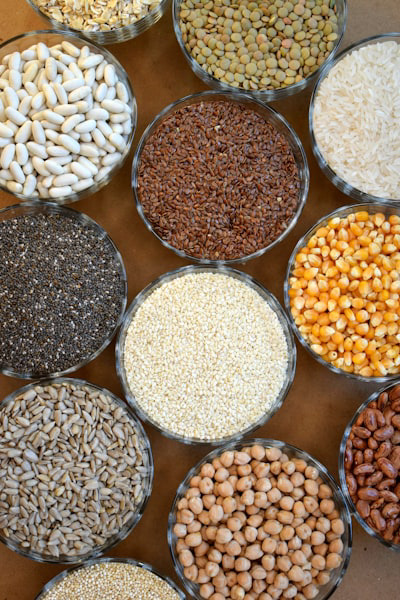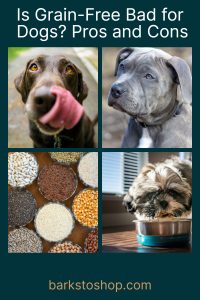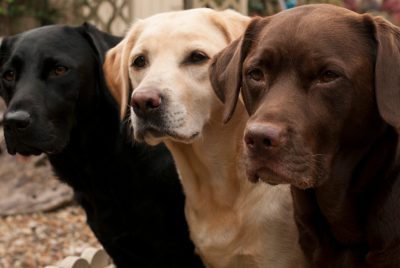Is Grain-Free Bad for Dogs? Pros and Cons
Post Disclaimer
We may earn a commission for purchases made using our links. Please see our Disclaimer to learn more.
Decoding the Truth: Is Grain-Free Bad for Dogs?
Key Highlights
- Grain-free diets for dogs have become popular in recent years, but there are pros and cons to consider.
- Grain-free dog food may provide relief for dogs with food allergies and intolerances.
- These diets usually have a higher protein content, which can benefit dogs.
- However, there have been reports of a potential link between grain-free diets and heart disease in dogs.
- It is important to consult a veterinarian to determine the best diet for your dog’s needs.
- The role of carbohydrates in a dog’s diet should also be considered when choosing between grain-free and traditional dog food.
Introduction
Grain-free diets are trendy for dogs. Pet owners choose grain-free food for their pets. These diets are seen as healthier but have pros and cons.
Supporters claim that grain-free diets can reduce allergies. Dogs allergic to grains may find relief from itching and digestive issues. Grain-free foods often contain more protein, which is good for active dogs.
Yet, there are concerns about heart disease in dogs on grain-free diets. The FDA is investigating cases of heart conditions in these dogs. Some think lacking grains could cause nutritional imbalances, leading to heart problems.
Dog owners must be aware of the pros and cons of grain-free diets. Consult a vet to determine what’s best for your dog’s health and ensure a balanced diet.
Understanding Grain-Free Dog Food
Grain-free dog food excludes grains like wheat, corn, or rice. These diets use alternative ingredients such as legumes or potatoes. The trend gained popularity in the early 2000s as pet owners wanted to mirror wild ancestors’ diets. However, the nutritional value and health effects of grain-free diets are debatable.

What Constitutes Grain-Free Dog Food?
Grain-free dog food is formulated without grains such as wheat, corn, or rice. Instead, these diets often use alternative carbohydrate sources like legumes (such as peas or lentils) or potatoes. Legumes and potatoes provide dogs with energy and can serve as a substitute for grains in their diet.
Grain-free dog food typically contains high-quality animal proteins as the primary ingredients, making it a great option for all dog breeds. These proteins can come from sources like chicken, beef, fish, or lamb. The protein content in grain-free dog food is often higher than traditional dog food, making it one of the best dog food options for dogs with higher activity levels or specific dietary needs. When choosing the right food for your dog, consider their breed and activity level to ensure they get the proper nutrition.
Additionally, grain-free dog food may include various fruits, vegetables, and other beneficial ingredients to provide essential nutrients. These ingredients can support overall health and well-being in dogs.
It is important to note that not all grain-free dog foods are created equal. Dog owners should look for reputable brands that adhere to high-quality standards and provide their pets with a well-balanced and complete diet.
The Rise of Grain-Free Diets for Dogs
Grain-free diets for dogs have become popular due to increased awareness of food allergies and a desire to mimic ancestral eating habits. This trend started in the early 2000s as pet owners aimed to replicate wild ancestors’ diets, believing dogs are carnivores and don’t need grains. However, concerns have been raised about a possible link between grain-free diets and heart disease, particularly in breeds like Golden Retrievers, Labradors, Whippets, Bulldogs, and Shih Tzus. Ongoing research explores the benefits and risks of these diets, including the use of exotic ingredients that may not be suitable for all dogs and the marketing tactics of pet food companies. It’s important to remember that dogs are not people, and what may work for human weight loss may not necessarily be suitable for our canine companions.
The Benefits of Grain-Free Diets for Dogs
Grain-free diets for dogs have been praised for potential benefits such as relief from food allergies and intolerances and higher protein content. These diets may provide a solution for pet parents with dogs who have known allergies to grains, as they eliminate potential triggers that can cause allergic reactions. Additionally, the higher protein content in grain-free dog food can benefit dogs with higher activity levels or specific dietary needs. However, weighing these benefits against the potential drawbacks of grain-free diets is a good idea.
Potential Allergy Relief
One of the potential benefits of a grain-free diet for dogs is the relief it may provide for dogs with food allergies and intolerances. Dogs can develop allergies to certain grains like wheat, corn, or soy, leading to symptoms such as itching, digestive issues, and skin irritations. By eliminating grains from their diet, dogs with known allergies or sensitivities to grains may experience relief from these symptoms.
Grain-free diets typically use alternative carbohydrate sources like legumes (such as peas or lentils) or potatoes. These ingredients are less likely to trigger allergic reactions in dogs than grains. By providing a grain-free diet, dog owners can potentially alleviate their pet’s discomfort and improve their overall quality of life. However, it is important to note that not all dog food allergies or intolerances are related to grains, including potential allergies to melamine, a chemical used in manufactured paper products and dog food bags. Consulting with a veterinarian is crucial to identify and manage any dietary sensitivities accurately.
Higher Protein Content and Its Advantages
Grain-free diets for dogs often have a higher protein content than traditional dog food. Protein is an essential nutrient for dogs, playing a crucial role in their growth, development, and overall health. The higher protein content in grain-free dog food can offer several advantages for dogs.
Firstly, protein is the building block of dogs’ muscles, tissues, and organs. Adequate protein intake is necessary to support muscle development and repair, especially in active or athletic dogs. Additionally, protein provides essential amino acids that are necessary for various biological processes in a dog’s body.
Furthermore, protein-rich diets can help dogs feel satiated and satisfied after meals, reducing the likelihood of overeating or excessive weight gain. This can be beneficial for dogs that are prone to obesity or weight-related health issues.
It is important to note that the quality of the protein source is crucial. High-quality animal proteins, such as chicken, beef, fish, or lamb, are desirable in grain-free dog food to ensure that dogs receive all the necessary amino acids and valuable nutrients for optimal health and well-being.
The Drawbacks of Grain-Free Diets
While grain-free diets for dogs have potential benefits, there are also drawbacks to consider. These include the risk of nutritional imbalances and reports of a potential link between grain-free diets and heart disease in dogs. When deciding on the best diet for your dog’s heart, it is important to weigh these potential drawbacks against the benefits, including the potential impact on your dog’s heart health from a lack of healthy grains.
Nutritional Imbalances and Risks
One drawback of grain-free diets for dogs is the risk of nutritional imbalances. Grains offer essential nutrients like fiber, vitamins, and minerals crucial for a dog’s health. Eliminating grains may lead to missing these vital nutrients, causing deficiencies or imbalances.
For instance, grains provide fiber important for a healthy digestive system and regular bowel movements. Without enough fiber, dogs on grain-free diets might face digestive problems like constipation or diarrhea.
Moreover, grains supply valuable vitamins and minerals that benefit a dog’s overall well-being. Removing grains could raise the risk of nutrient deficiencies, affecting a dog’s health and energy levels.
Ensuring that any grain-free diet offers a balanced nutritional profile that meets a dog’s specific needs is vital. Consulting a vet is crucial to effectively fulfilling a dog’s nutritional requirements.
The Controversy Around DCM and Grain-Free Foods
Recently, there has been talk about grain-free diets possibly causing heart problems in dogs. Dilated cardiomyopathy (DCM) is a serious heart issue where the muscle weakens, affecting heart function. The U.S. Food and Drug Administration (FDA) is looking into cases of DCM in dogs on grain-free diets.
Researchers are studying why this might happen. Some think these diets lacking grains could lead to nutrient imbalances, possibly causing DCM. It’s important to know that not all dogs on grain-free diets get DCM, and what exactly causes this condition is unclear.
The FDA is working with experts to understand this potential link better. They urge dog owners to report any DCM cases to help with further research.
Grain-Free vs. Traditional Dog Food Diets
Dog owners can face a complex decision about whether to feed their dogs grain-free or traditional food. Understanding the differences between these two types of diets and their potential impact on a dog’s health is crucial when making this choice.
Comparing Nutritional Values
When comparing grain-free and traditional dog food diets, it is important to consider the nutritional values of each. A text table comparing the nutritional values of grain-free and traditional dog food diets is shown below:
| Nutritional Component | Grain-Free Dog Food | Traditional Dog Food |
| Protein Content | High | Varies |
| Carbohydrate Source | Legumes and Potatoes | Grains |
| Fiber Content | Varies | Moderate to High |
| Essential Vitamins and Minerals | Varies | Balanced |
It is important to note that the specific nutritional values will vary depending on the brand and formulation of the dog food. Reading and comparing the labels of different dog food products can provide more detailed information about their nutritional composition.
Making the Right Choice for Your Dog
Choosing the right food for your dog can be challenging. Based on your dog’s needs, ask a vet about grain-free or regular food.
Consider age, breed, activity, and allergies. A vet can advise on your dog’s specific dietary needs.
Watch your dog’s health when changing their diet. Note changes in coat, energy, digestion, and overall health. Consult the vet if needed.
Each dog is different; what suits one may not suit another. Work with your vet to choose the best diet for your dog.
The Role of Carbohydrates in Dog Food
Carbohydrates play a crucial role in a dog’s diet as they are an important energy source. Dogs have the ability to digest and utilize carbohydrates as an energy source alongside proteins and fats. Carbohydrates from grains provide dietary fiber, which supports a healthy digestive system and regular bowel movements in dogs. While dogs are considered omnivores, meaning they can consume and digest meat and plant-based foods, the specific carbohydrate requirements may vary depending on the dog’s needs. Consulting with a veterinarian can help determine the appropriate carbohydrate balance in a dog’s diet.
Understanding Carbs and Their Sources
Carbohydrates are an important source of energy for dogs. However, not all carbs are created equal. Whole grains, such as rice, oats, and barley, are considered healthy sources of carbohydrates for dogs. Whole grains provide essential nutrients and fiber. On the other hand, corn gluten and wheat gluten are common allergens for some dogs. These ingredients may cause digestive issues and food allergies in certain dogs. It is important to consider your dog’s needs and allergies when selecting a carbohydrate source for their diet.
Grain-Free Alternatives to Traditional Carbs
Grain-free diets often rely on legume seeds, such as peas and lentils, as alternatives to traditional carbohydrates. Legumes are rich in protein and fiber, making them a popular choice for grain-free dog foods. These ingredients can provide dogs with the necessary nutrients and energy. However, some veterinary professionals have expressed concern about the potential risks of feeding dogs a diet high in legumes. It is important to consult your veterinarian to determine if a grain-free diet is appropriate for your dog and to ensure they receive a balanced and nutritious diet.
Vets’ Views on Grain-Free Diets
Veterinary cardiologists and other veterinary professionals have differing opinions on the use of grain-free diets for dogs. Some professionals, like Lisa M. Freeman, DVM, Ph.D., DACVN, are concerned about the potential link between grain-free diets and canine dilated cardiomyopathy (DCM). In contrast, others believe that grain-free diets can be a healthy option for certain dogs. Dog owners need to consult with their veterinarians and consider their dog’s individual needs and health history when deciding whether to feed them a boutique grain-free diet, especially after the FDA investigated the potential risks of grain-free diets in April 2019.
Professional Opinions on Grain-Free Feeding
Veterinary cardiologists and other professionals have been studying the potential risks of grain-free diets and their association with canine dilated cardiomyopathy (DCM). DCM is a heart condition that affects the heart muscle and can lead to heart failure. While the exact cause of DCM is still unknown, some studies have suggested a possible link between feeding a BEG diet, specifically those containing legume seeds like peas and lentils, and the development of DCM in certain dogs with a known genetic predisposition. However, more research is needed to fully understand the relationship between grain-free diets and reports of DCM.
Recommendations for Dog Owners Considering Grain-Free
If you are considering feeding your dog a grain-free diet, it is important to consult with your veterinarian. Your vet can provide valuable insight into your dog’s specific dietary needs and any potential health issues affecting their diet. They can also help you determine if a grain-free diet is appropriate for your dog based on age, breed, known allergies, or sensitivities. Your veterinarian may recommend conducting regular health check-ups and monitoring your dog’s overall health and well-being while on a grain-free diet to detect potential issues early on. It is also important to consider the potential risks of a grain-free diet, such as the link to dilated cardiomyopathy (DCM), and discuss these concerns with your veterinarian. Together, you can make an informed decision about your dog’s diet and ensure their health and well-being. As a general recommendation, it is always best to consult your veterinarian before significantly changing your dog’s diet, including switching to a grain-free diet.
Transitioning to a Grain-Free Diet
Transitioning your dog to a grain-free diet should be done gradually to minimize digestive upset or discomfort. Start by mixing a small amount of the new grain-free food with their current food and gradually increase the proportion of the new food over the course of a week or two. Monitor your dog’s health during the transition period, including their appetite, energy levels, and stool consistency. Consult your veterinarian for further guidance if you notice any changes or concerns.
How to Switch Your Dog’s Food Safely
When switching your dog’s food to a grain-free diet, it is important to do so safely and gradually. Start by mixing a small amount of the new grain-free food with their current food and gradually increase the proportion of the new food over the course of a week or two. This gradual transition helps your dog’s digestive system adjust to the new food and reduces the risk of digestive upset. For puppies or dogs with specific dietary needs, consult your veterinarian for personalized guidance on switching to a grain-free diet. Obedience training is also important during the transition period to ensure your dog is not consuming any other foods or treats that may contain grains.
Monitoring Your Dog’s Health During Transition
Monitoring your dog’s overall health and well-being is important when transitioning to a grain-free diet. Keep an eye on their appetite, energy levels, and stool consistency. Any significant abnormalities or changes in these areas should be discussed with your veterinarian. Additionally, it is essential to remain vigilant about your dog’s heart health, especially if you have concerns about the potential risks of a grain-free diet and their association with dilated cardiomyopathy (DCM). Regular check-ups and consultations with your veterinarian are crucial for monitoring your dog’s heart health and catching any potential issues early on.
Conclusion
In conclusion, while grain-free diets for dogs offer potential benefits like allergy relief and higher protein content, there are also drawbacks to consider, such as nutritional imbalances and the controversy surrounding DCM. It’s essential to weigh the pros and cons carefully, considering your dog’s individual needs and consulting with a veterinarian for guidance on making the right dietary choice. Understanding the role of carbohydrates in dog food and transitioning safely to a grain-free diet are crucial steps in ensuring your furry friend’s health and well-being. Prioritize your dog’s overall health and happiness when deciding on their diet.
Frequently Asked Questions
Are all grain-free dog foods the same?
Not all grain-free dog foods are the same. The ingredients and formulations can vary among different brands and products. When selecting a grain-free dog food, it is important to carefully read the labels and consider your dog’s needs and potential health issues.
How do I know if my dog needs a grain-free diet?
Determining if your dog needs a grain-free diet should be done in consultation with your veterinarian. They can help you identify food allergies or sensitivities requiring a grain-free diet. Your vet will consider your dog’s overall health, specific dietary needs, and any known allergens when making recommendations for their diet.





